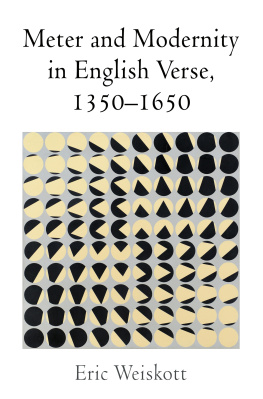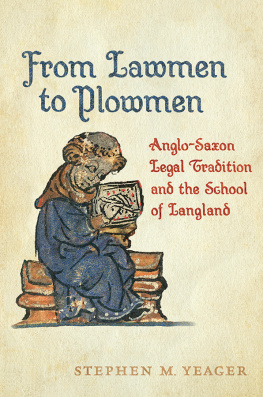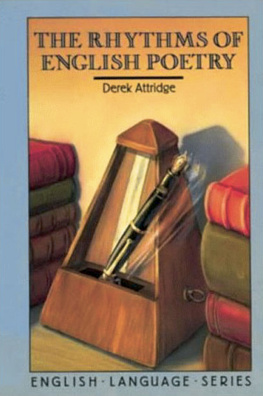
Meter and Modernity
in English Verse,
13501650
Meter and Modernity
in English Verse,
13501650
Eric Weiskott
UNIVERSITY OF PENNSYLVANIA PRESS
PHILADELPHIA
Copyright 2021 University of Pennsylvania Press
All rights reserved. Except for brief quotations used for
purposes of review or scholarly citation, none of this book may
be reproduced in any form by any means without written
permission from the publisher.
Published by
University of Pennsylvania Press
Philadelphia, Pennsylvania 19104-4112
www.upenn.edu/pennpress
Printed in the United States of America on acid-free paper
10 9 8 7 6 5 4 3 2 1
Library of Congress Cataloging-in-Publication Data
ISBN 978-0-8122-5264-4
To Sofia
CONTENTS
ABBREVIATIONS
CR | Chaucer Review |
Crum | Margaret Crum, ed., First-Line Index of English Poetry 15001800 in Manuscripts of the Bodleian Library Oxford |
DMLBS | Dictionary of Medieval Latin from British Sources |
DOE | Dictionary of Old English |
ELH | English Literary History |
ESTC | English Short Title Catalogue Online, http://estc.bl.uk |
May and Ringler | Steven W. May and William A. Ringler Jr., Elizabethan Poetry: A Bibliography and First-Line Index of English Verse, 15591603 |
ME | Middle English |
MED | Middle English Dictionary |
NIMEV | Julia Boffey and A. S. G. Edwards, A New Index of Middle English Verse |
OE | Old English |
OED | Oxford English Dictionary |
OF | Old French |
ON | Old Norse |
RES | Review of English Studies |
Ringler | William A. Ringler Jr., Bibliography and Index of English Verse in Manuscript 15011558 |
SAC | Studies in the Age of Chaucer |
STC | A. W. Pollard and G. R. Redgrave, A Short-Title Catalogue of Books Printed in England, Scotland and Ireland, and of English Books Printed Abroad, 14751640 |
YLS | Yearbook of Langland Studies |
NOTE OF QUOTATIONS AND SCANSION
QUOTATIONS
In quotations from manuscripts and in the edited text of the Ireland Prophecy in , | or a tabbed space represents the caesura between the a-verse and the b-verse.
SCANSION
S represents a metrically stressed syllable, and x represents a metrically unstressed syllable or its equivalent through elision. For example, a normal line of iambic pentameter is xSxSxSxSxS.
PREFACE
This book issues from a particular disciplinary-historical context. I belong to a generation of literary scholars for whom periodization is a foregone conclusion. Period specialty was the essential element of our applications to graduate programs. The minimum price of entry to academia was to designate oneself a medievalist, a Victorianist, and so on. I entered the English PhD program at Yale University in 2009 as an Anglo-Saxonist. Scholarly subspecialization by time period is old news, but it has assumed a professional importance for my cohort that feels like an intensification as compared with previous generations. We were encouraged to find common cause with peers studying our period in other disciplines, a dream of transdisciplinary period coherence that James Simpson has queried on general principle.)
Not being in the room has its consequences. Invested with a political valuation, the narrative of modernity locates premodern literature and its study at the margins of the field. The episode at Yale recapitulated, at a trivial level of particularity, the historical drama whereby modernity, via the Renaissance, We understand their language, but they dont understand ours, a medievalist friend once observed, with double meaning. We sometimes find ourselves in the position of witnessing new scholarly movements, associated with later periods, that unwittingly resemble the work we have been presenting and publishing for years. Medievalists who wish to speak back to theoretical and methodological trends in the field are expected to represent ourselves as newcomers, or emissaries from a faraway land. Medievalists bear some responsibility for this dynamic. When we accept modernity as the limit of our intellectual energies, we consent in our own professional marginalization. Medieval/Renaissance, or med/Ren, is a standard specification for pre-1700 English literature teaching positions at colleges and smaller universities. In these cases, the exigencies of institutional resources under austerity have reunified a partitioned literary terrain; but the nonnegotiable elective is always Shakespeare. In a sense, medievalists arent in the room whether we are in the room or not.
There is a history behind this. In Why Literary Periods Mattered, Ted Underwood traces an important part of that history. Underwoods book centers on the early nineteenth century. Yet its arguments about the formation of English studies return again and again to the teaching and literary representation of the Middle Ages. More even than Underwood indicates, the book demonstrates the foundational importance of medievalism to the discipline of English. Walter Scott is the hero, or villain, of the book. According to Underwood, English studies conformed to Scotts vision of historical cultivation to an extent that presentday English professors might be embarrassed to realize. Underwood first describes this vision in its natural setting, Scotts early Waverley novels and other contemporary novels, poems, handbooks of chronology, and public discourse about history. Underwood shows that a paradoxical proposition about history, that our inability to understand a prestigious cultural past is the true source of cultural prestige, gained currency in imaginative writing during Scotts lifetime (17711832).in the 1840s. Emphasizing the status quo of the 1820s and 1830s, in which London professors regularly taught the whole gamut of English literature in one term, Underwood conveys the strangeness of periodization. Here, too, medievalism looms large. The old nonperiodized curriculum, as against the raciallinguistic factionalism of Scotts Ivanhoe, had emphasized continuity between Saxon, Norman, and English phases of language history. The first course taught in the new, periodized format was a course given by Frederick Denison Maurice on the General Prologue to Geoffrey Chaucers Canterbury Tales.
Underwoods argument has a social dimension. The form of historical understanding displaced by Scott and other writers had been a vision of social continuity identifiable as a fantasy-projection of the aristocracy. Regency-era writers instead stressed the unknowability of the past, but Underwood diagnoses this conception of history in turn as expressive of a specifically middle-class ethos. The speakers of John Keatss sonnets cant afford the Grand Tour but can feel an immediate experience of the alienation produced by historical time. In one of Maurices letters, a characteristic bourgeois experience, a visit to the British Museum, triggers the theologian and professor to rhapsodize about historical and spiritual transcendence. The covertly middle-class aesthetic of Scotts historical novels became the covertly middle-class sensibility of literary studies. More embarrassing news for English professors.
Next page











